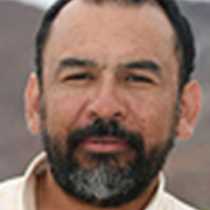Sand Dollar Beach and Hull Canal, Magdalena Bay
Clouds and wind were the most obvious weather characteristics this morning at the beginning of our voyage among the gray whales. Despite this, we left our comfortable night anchorage and visited one of the most impressive and beautiful ecosystems in Baja California: the sand dunes on Magdalena Island. In fact, as we walked across the ochre colored sand (like in a moon made of gold) our eyes witnessed how these dunes are created by the action of the strong northwest winds, leaving many beautiful and strange patterns on the surface like waves, strata and crests. Hundreds of tracks, among which were many made by coyotes, jackrabbits and beetles, dotted the humped landscape and took away the general impression of a barren and empty place. We also observed the succulent but salt-tolerant plants like sea purselane, sand verbenas, iodine bush, rattleweed and marigolds as we progressed on this nice walk. Later, we got the Pacific side of the island (that we call the sand dollar beach) and a large number of whimbrels, willets and marbled godwits were seen standing on a little dry area of the tidal interval, maybe digesting food. They went back and forth as the strong breakers were hitting the beach. Sometimes they flew for few seconds forming a dense and active brown flock (photo).
By noon we left the dunes to continue our navigation through the Canal de la Soledad, or Hull Canal, en route to Lopez Mateos port's area. Along this magnificent and unique canal, we observed the dense patches of red mangroves escorted by small and scattered aggregations of white and black mangroves. We learned that these mangroves are at the northernmost limit of their distribution, and never get higher than probably 21 feet. Hundreds of frigate birds, pelicans, cormorants, gulls and other birds were seen perched on the mangroves' branches or soaring above at high altitude. Two, and later a group of four coyotes, were observed patrolling the sandy shore of Magdalena Island looking for the scarce and elusive food, that may consist in dead marine creatures washed up by the tides, or anything that they can get alive, including plants. Into the water, several individuals of the bottlenose dolphin were seen transiting without hurry in the opposite direction of the Sea Lion, our ship. Beyond certain point of the canal, called La Florida, we started to see blows produced by cow and calf pairs of gray whales. We navigated the rest of the afternoon observing these gentle giants from the ship. Mothers were occupied nursing, protecting or helping the babies to get the surface to breathe. Their different patterns of coloration on their skins, caused by natural pigmentation, scars, lice and barnacles, were remarkable, especially in the old cows. A solitary whale breached up to seven times, to our delight. The beginning of our voyage could not have been better.
Clouds and wind were the most obvious weather characteristics this morning at the beginning of our voyage among the gray whales. Despite this, we left our comfortable night anchorage and visited one of the most impressive and beautiful ecosystems in Baja California: the sand dunes on Magdalena Island. In fact, as we walked across the ochre colored sand (like in a moon made of gold) our eyes witnessed how these dunes are created by the action of the strong northwest winds, leaving many beautiful and strange patterns on the surface like waves, strata and crests. Hundreds of tracks, among which were many made by coyotes, jackrabbits and beetles, dotted the humped landscape and took away the general impression of a barren and empty place. We also observed the succulent but salt-tolerant plants like sea purselane, sand verbenas, iodine bush, rattleweed and marigolds as we progressed on this nice walk. Later, we got the Pacific side of the island (that we call the sand dollar beach) and a large number of whimbrels, willets and marbled godwits were seen standing on a little dry area of the tidal interval, maybe digesting food. They went back and forth as the strong breakers were hitting the beach. Sometimes they flew for few seconds forming a dense and active brown flock (photo).
By noon we left the dunes to continue our navigation through the Canal de la Soledad, or Hull Canal, en route to Lopez Mateos port's area. Along this magnificent and unique canal, we observed the dense patches of red mangroves escorted by small and scattered aggregations of white and black mangroves. We learned that these mangroves are at the northernmost limit of their distribution, and never get higher than probably 21 feet. Hundreds of frigate birds, pelicans, cormorants, gulls and other birds were seen perched on the mangroves' branches or soaring above at high altitude. Two, and later a group of four coyotes, were observed patrolling the sandy shore of Magdalena Island looking for the scarce and elusive food, that may consist in dead marine creatures washed up by the tides, or anything that they can get alive, including plants. Into the water, several individuals of the bottlenose dolphin were seen transiting without hurry in the opposite direction of the Sea Lion, our ship. Beyond certain point of the canal, called La Florida, we started to see blows produced by cow and calf pairs of gray whales. We navigated the rest of the afternoon observing these gentle giants from the ship. Mothers were occupied nursing, protecting or helping the babies to get the surface to breathe. Their different patterns of coloration on their skins, caused by natural pigmentation, scars, lice and barnacles, were remarkable, especially in the old cows. A solitary whale breached up to seven times, to our delight. The beginning of our voyage could not have been better.




